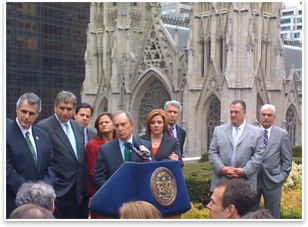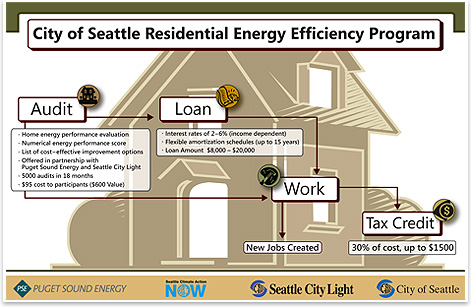Measuring
Sustainability Performance Means Establishing Design Value
Different approaches in Seattle and New York City share a common goal
by Gideon Fink Shapiro
How do you .
. . develop
a dependable database of energy and zero-carbon performance?
Summary: Once
overshadowed by the promise of zero-carbon new buildings, the less
glamorous work of retrofitting existing buildings for increased efficiency
is quickly gaining momentum. Increasingly widespread benchmarking
and disclosure standards are making energy performance an important
new metric across the industry.

NYC Mayor Michael R. Bloomberg, Council Speaker
Christine Quinn, and leaders of building trades and environmental
groups introduce the "Greener Greater Buildings Plan" on
April 22.
On April 22, the 39th annual Earth Day, environmental and building
groups joined the mayors of New York and Seattle to introduce new
programs designed to reduce the energy consumption and carbon emissions
of their respective cities’ building stock. The Seattle program relies
on a set of market incentives to encourage owners to measure and
upgrade their building's energy performance. The more stringent New
York legislation would pair market incentives with efficiency requirements
for all commercial, residential, and government buildings. Both programs
use federal stimulus funds to provide low-interest financing for
building upgrades.
These two new programs build on earlier benchmarking laws in California
(2007) and Washington, DC (2008). Austin, Chicago, Berkeley, and
Portland, Ore. are not far behind. Benchmarking is the practice of
evaluating buildings' energy efficiency performance on a standard
scale in order to compare them. Similar to how a car's estimated
fuel economy helps measure its worth, a building's benchmark efficiency
score helps determine its market value to owners, tenants, and prospective
buyers.
 The
Washington, D.C.-based Institute for Market Transformation (IMT)
has been a staunch advocate and consultant for developing benchmarking
policies. Executive Director Cliff Majersik (photoo left) views benchmarking
as a means to re-optimize the market toward green building, and hence
slow climate change. Once owners are made aware of their building's
energy score, he says, "there's low-hanging fruit, investment
opportunities with low risk and high reward that increase performance." Thus
private and public interests begin to dovetail. The Energy Star rating
developed by the Environmental Protection Agency is now the most
common benchmarking system for buildings. The
Washington, D.C.-based Institute for Market Transformation (IMT)
has been a staunch advocate and consultant for developing benchmarking
policies. Executive Director Cliff Majersik (photoo left) views benchmarking
as a means to re-optimize the market toward green building, and hence
slow climate change. Once owners are made aware of their building's
energy score, he says, "there's low-hanging fruit, investment
opportunities with low risk and high reward that increase performance." Thus
private and public interests begin to dovetail. The Energy Star rating
developed by the Environmental Protection Agency is now the most
common benchmarking system for buildings.
The energy consumed by New York's one million buildings accounts
for a whopping 80 percent of the city's carbon emissions, according
to Rohit Aggarwala, director of Mayor Michael R. Bloomberg's Office
of Long-Term Planning and Sustainability. The agency estimates that
85 percent of the city's buildings in 2030 are already standing today.
In addition to requiring benchmarking for all existing and new city
buildings, the "Greener, Greater Buildings Plan" would
require all renovations to be green renovations, meeting guidelines
of the International Energy Conservation Code regardless of the size
or scope of work. Formerly, many renovations were exempt from the
code if they composed less than half of a building.
The plan would also require existing buildings over 50,000 square
feet to conduct energy audits and efficiency upgrades at least once
every decade. Sensitive to financial as well as environmental interests,
only those retrofits that would pay for themselves within five years
through energy savings would be required, such as insulating pipes,
replacing inefficient lighting, and installing low-flow fixtures.
This systematic, ongoing improvement of existing buildings is the
boldest and most original aspect of the six-point plan, says Aggarwala.
A job training program and $16 million loan fund would help ensure
that the required work can be implemented by skilled technicians
and paid for by owners. If implemented, the plan is predicted to
reduce the city's total carbon footprint by 5 percent—the equivalent
of eliminating all carbon emissions from a city the size of Oakland.
In Seattle, 20 percent of carbon emissions come from residential
and commercial buildings, while around 60 percent comes from transportation.
Beginning next year, Seattle will require commercial buildings larger
than 50,000 square feet and multifamily buildings with more than
20 units to measure and disclose their energy use. Improvements are
optional. "We're trying to do a lot by mandating information
and providing incentives for the upgrades that would follow in hopes
that the market would respond to more information," says Amanda
Eichel, climate protection advisor in the Seattle Office of Sustainability
and Environment.
Seattle's pilot program makes it easier for individual homeowners
to improve their home's efficiency. The city convinced the energy
utilities to offer 5,000 home energy audits for $95 instead of the
usual $600, in hopes that the savings by both the company and homeowner
will ultimately exceed the cost of the audit. Improvements following
the audit are not mandatory, but residents can choose to take advantage
of low-interest loans (as low as 2 percent rates for low-income households)
which they don't have to repay until they sell the house. Eichel
says the city will have enough data to assess the residential program
in 2011, and the benchmarking program by 2012.

Poster for the new Seattle energy efficiency program,
in which residents can receive energy audits at a steep discount,
and then borrow money at low interest rates to make efficiency improvements.
Programs for eco-effective renovations and retrofits will help stimulate
the economy, advocates predict. Numerous construction unions have
endorsed the New York plan, in part because of the estimated 19,000
construction jobs it will supposedly create. Whether it will bring
more business to architects remains to be seen, since many of the
building upgrades can be accomplished without an architect's help.
But what is good for the building industry is generally good for
architecture. "You want to be creative" says Paul Katz,
FAIA, a partner at KPF, "The easiest way to stimulate the construction
industry is through renovation. And, of course, renovation and reuse
can be sustainable."
One of the main obstacles the industry must overcome is the conundrum
of split priorities. When the interests of the designer, the building
owner, and the tenant do not align, the result is inefficient buildings,
says Majersik, because "no one thinks they'll get paid for building
efficiently." Another challenge is accurately projecting energy
savings in a volatile market. In New York, passage of the Greener,
Greater Buildings Plan will depend partially on support from building
owners who are wary of promises that upgrades will pay for themselves
within five years. The city council could vote on the plan as early
as late summer or fall.
Policy, practice, and technology take turns leading the charge toward
more sustainable cities. Just a week after New York unveiled its
carbon-reduction plan, the Lightfair International trade show presented
an overwhelming variety of LED bulbs and fixtures, many of which
will find their way into the next generation of renovations. In many
cases, it will be the architects' job to decide how and which new
technology is implemented, and how policy goals are met in practice.
|



 The
Washington, D.C.-based Institute for Market Transformation (IMT)
has been a staunch advocate and consultant for developing benchmarking
policies. Executive Director Cliff Majersik (photoo left) views benchmarking
as a means to re-optimize the market toward green building, and hence
slow climate change. Once owners are made aware of their building's
energy score, he says, "there's low-hanging fruit, investment
opportunities with low risk and high reward that increase performance." Thus
private and public interests begin to dovetail. The Energy Star rating
developed by the Environmental Protection Agency is now the most
common benchmarking system for buildings.
The
Washington, D.C.-based Institute for Market Transformation (IMT)
has been a staunch advocate and consultant for developing benchmarking
policies. Executive Director Cliff Majersik (photoo left) views benchmarking
as a means to re-optimize the market toward green building, and hence
slow climate change. Once owners are made aware of their building's
energy score, he says, "there's low-hanging fruit, investment
opportunities with low risk and high reward that increase performance." Thus
private and public interests begin to dovetail. The Energy Star rating
developed by the Environmental Protection Agency is now the most
common benchmarking system for buildings.
